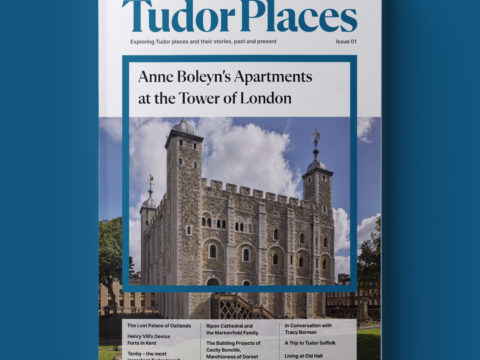Katherine Willoughby: Life Story
Chapter 4 : Court Lady
The other great excitement of 1539 was Henry’s decision to remarry. His choice fell on Anne, sister of the Duke of Cleves, and the purpose was to give England allies against the recent alliance of François I of France and Emperor Charles V, which it was feared would lead to invasion.
Katherine was appointed as one of the ‘great ladies’ to be attached to the new queen’s household. The great ladies were the wives of important peers who would not be in regular attendance, but whose presence would add dignity to the queen’s court. The other great ladies were the king’s daughter-in-law, the Duchess of Richmond; Lady Margaret Douglas, his niece; the Countess of Sussex; Lady Howard and Lady Clinton (the king’s former mistress, Elizabeth Blount).
Anne of Cleves travelled through the various northern German states to reach the English territories at Calais, and, after a fortnight’s delay, sailed for Dover, where she was met by Katherine and the other members of her new household in the early evening of 27th December. They were to form her retinue until she reached London. It is unrecorded whether Katherine was present at the fateful moment when Henry VIII first set eyes on Anne of Cleves and received a less hearty welcome than he had anticipated, Anne not having understood that the man who invaded her room, dressed as a merchant, was actually the king.
We do not know what Katherine thought of Queen Anne, some four years her senior, but most people spoke well of her – even the king liked her, he just was not physically attracted to her. Katherine probably welcomed the opportunity to live at court, amongst her friends, and at the centre of events. But, as the year progressed, it became apparent that the royal marriage was a disaster, and that Henry had his eye on one of Queen Anne’s maids-of-honour, Katheryn Howard. Politically, this was not good for Katherine. Miss Howard was the niece of the Duke of Norfolk, and Norfolk and Suffolk were rivals for influence in East Anglia. Although they were obliged to work closely together, they did not have an especially good personal relationship. Norfolk, and by extension his niece, were also religious conservatives, and their rise further jeopardised religious reform.
Henry’s marriage to Anne of Cleves was annulled, and he married Katheryn Howard – as part of the fall-out, Thomas Cromwell, another religious reformer, was executed. Nothing definite is heard of Katherine that year until her servants are noted as receiving the customary New Year’s tip from the king. 20s was distributed amongst them – the same amount as received by the servants of the king’s second daughter, Elizabeth, the Duchesses of Richmond and Norfolk and the king’s niece, Frances, Lady Dorset. The Duke’s servants received 40s, as did those of Prince Edward. Those who did best were the servants of the Lady Mary, who shared an impressive 53s 4d.
Since Suffolk, now Lord President of the Council, spent most of the year in and about London, attending to Privy Council business, it is likely that Katherine was with him for some of the time, and she was certainly present on the occasion when Anne of Cleves came to visit Henry and his new bride at Hampton Court. Katherine and Lady Hertford met Anne and, after showing her where she was to be lodged, took her to see the queen – once her maid-of-honour. Anne behaved with all of the dignity and politesse that might be expected of a great lady, and the visit was a great success.
During the summer of 1541, Katherine played hostess as king and court journeyed from London to York. Suffolk wrote to his friends, asking for help in supplying the royal table with the much-prized venison. Henry, accompanied by Queen Katheryn, Lady Mary, the Duke of Norfolk and the more senior members of the court, arrived at Grimsthorpe on 5th August. They stayed until 8th August, before departing for Sleaford, with Suffolk joining them, although it is unclear if Katherine did.
By November, they were both at home at Grimsthorpe, when Suffolk was sent for urgently, as the scandal surrounding Queen Katheryn broke. From this time forward, the duke was largely in and around the royal palaces in London, and Katherine was probably with him.
Following the beheading of Katheryn Howard in February 1542, Henry remained a widower for some seventeen months and until Christmas was reported as depressed. He shook off his morose mood, and invited his daughter ‘with a great repair of ladies’ to come to Hampton Court to celebrate Christmas and the New Year. Katherine was probably included, and, in the following spring, it is likely that she met another Katherine, who was to play an influential part in her life.
This was Lady Latimer, born Katherine Parr, whose mother, like Katherine’s own, had served Katharine of Aragon. Lady Latimer was a friend of the Lady Mary, and, in the spring of 1543, spent considerable time with Mary. The two Katherines soon struck up a warm friendship.
Lady Latimer was widowed in March, and within weeks it was rumoured that Henry VIII intended to marry her. Initially reluctant, Lady Latimer was persuaded that it was her duty to marry the king, and Katherine was one of the witnesses to the wedding on 12th July 1543.
Other than the king’s daughters and niece, the other female guests were the new queen’s sister, Anne Herbert; Jane, Lady Lisle (not the Lady Lisle who had plied Katherine with spaniels and wine, but the new holder of the title); and Anne, Countess of Hertford. These latter three ladies, along with Katherine, became the core of Queen Katherine’s household, and within months it was apparent that they were strong supporters of the reformed religion.




